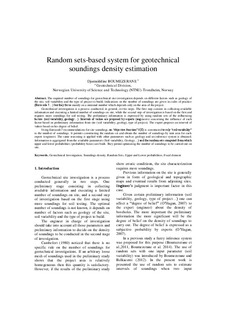| dc.contributor.author | Boumezerane, Djamalddine | |
| dc.date.accessioned | 2015-10-28T12:15:38Z | |
| dc.date.accessioned | 2016-06-27T11:06:43Z | |
| dc.date.available | 2015-10-28T12:15:38Z | |
| dc.date.available | 2016-06-27T11:06:43Z | |
| dc.date.issued | 2015 | |
| dc.identifier.citation | Schweckendiek, Timo; van Tol, Alexander Franciscus; Pereboom, Dirk; van Staveren, M. Th.; Cools, P.M.C.B.M [Eds.] Proceedings of ISGSR2015: Geotechnical Safety and Risk V p. 201-206, IOS Press, 2015 | nb_NO |
| dc.identifier.isbn | 978-1-61499-579-1 | |
| dc.identifier.uri | http://hdl.handle.net/11250/2394201 | |
| dc.description.abstract | The required number of soundings for geotechnical site investigation depends on different factors such as geology of the site, soil variability and the type of project to build. Indications on the number of soundings are given in codes of practice (Eurocode 7...) but they focus mainly on a minimal number which depends only on the area of the project. Geotechnical investigation is a process conducted, in general, in two steps. The first step consists in collecting available information and executing a limited number of soundings on site, while the second step of investigation is based on the first and requires more soundings for soil testing. The preliminary information is expressed by using random sets of the influencing factors (soil variability, geology...). Intervals of values are proposed by experts (engineers) concerning the influence of each factor based on preliminary information from site (soil variability, geology, type of project). The expert proposes an interval of values based on his degree of belief. Using Eurocode7 recommendations for site soundings, an “objective function” f(X) is constructed to rely “soil variability” to the number of soundings. It permits constructing the random set and obtain the number of soundings by unit area for each expert (engineer). The same reasoning is applied with other parameters such as geology and an inference system is obtained. Information is aggregated from the available parameters (Soil variability, Geology...) and the random sets computed from which upper and lower probabilities (probability boxes) are built. They permit optimizing the number of soundings to be carried out on site. | nb_NO |
| dc.language.iso | eng | nb_NO |
| dc.publisher | IOS Press | nb_NO |
| dc.title | Random sets-based system for geotechnical soundings density estimation | nb_NO |
| dc.type | Chapter | nb_NO |
| dc.date.updated | 2015-10-28T12:15:38Z | |
| dc.description.version | submittedVersion | |
| dc.source.pagenumber | 201-206 | nb_NO |
| dc.source.volume | 2 | nb_NO |
| dc.source.journal | Proceedings of ISGSR2015: Geotechnical Safety and Risk V | nb_NO |
| dc.identifier.doi | 10.3233/978-1-61499-580-7-203 | |
| dc.identifier.cristin | 1284235 | |
| dc.description.localcode | Author preprint | nb_NO |
